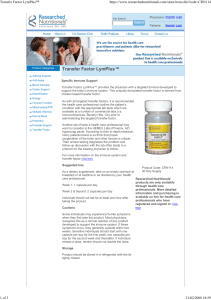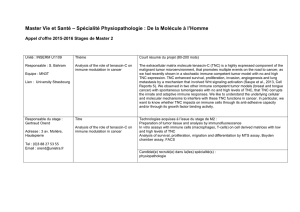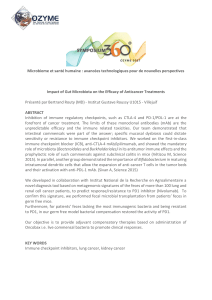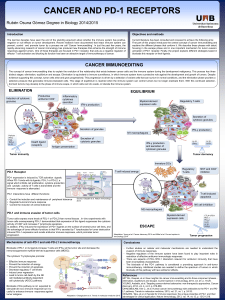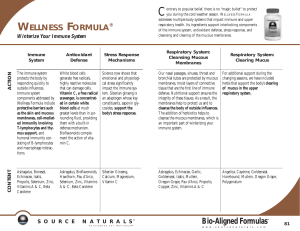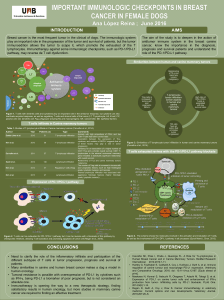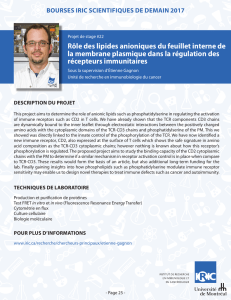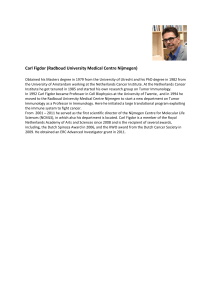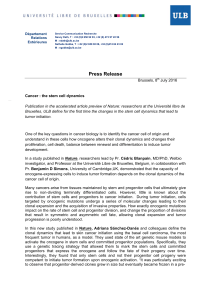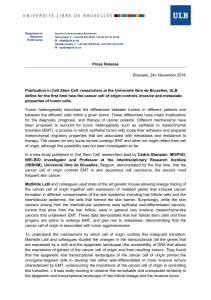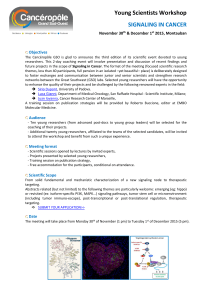Biomarqueurs immunologiques intra-tissulaires pour la définition du
publicité
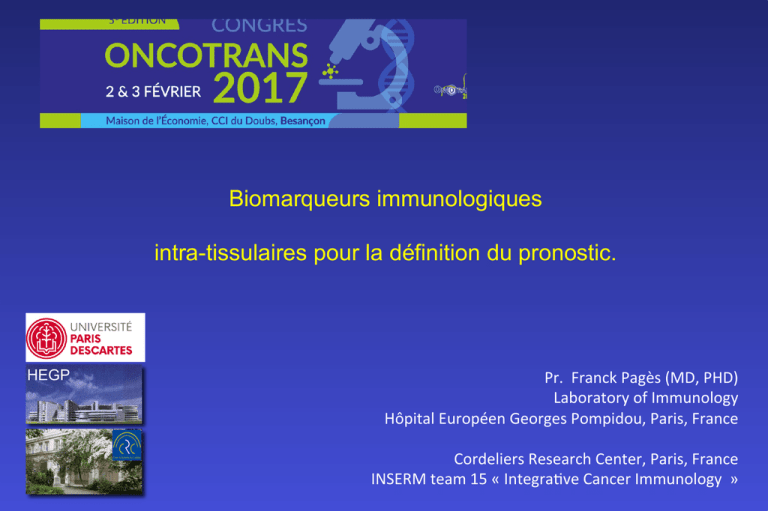
Biomarqueurs immunologiques intra-tissulaires pour la définition du pronostic. HEGP Pr. Franck Pagès (MD, PHD) Laboratory of Immunology Hôpital Européen Georges Pompidou, Paris, France Cordeliers Research Center, Paris, France INSERM team 15 « IntegraMve Cancer Immunology » ! Disclosures Collaborative Research Agreement (grant): . BioMerieux, HalioDx Participation to Scientific Advisory Boards & Meetings: . BMS, Roche, Janssen, Merck Consultant: . Sanofi, Roche INSERM* Patents: methods for prognostic evaluation of cancer patents #05292200.2 (2005), 2010, 2011 * (French National Institute of Health and Medical Research) ! From bench to bedside After years of controversy,….. Immunotherapies have become the hot new thing in cancer drug development 2013 checkpoint inhibitors . Ac anti- CTLA-4 . Ac anti- PD-1 . Ac anti- PD-L1 Melanoma Lung cancer (NSCLC) Renal cancer Lung cancer (SCLC) Bladder cancer MSI+ colorectal cancers Head and neck Merkel cell carcinoma Hodgkin disease Mesothelioma Gastric / oesophagus cancer Hepatocarcinoma Ovarian cancer Triple negative breast cancer ! Clinical Trials with immune checkpoint inhibitors Presented By J. Chaft at 2016 ASCO Annual Meeting ! Clinical Trials with immune checkpoint inhibitors Presented By J. Chaft at 2016 ASCO Annual Meeting From bench to bedside Lot of possibilities: single agents or combinations Presented By J. Chaft at 2016 ASCO Annual Meeting ! The Biomarkers Why do we need biomarkers ? ü AnMcipate the natural progression or agressivness of the tumor (PronosMc markers) (PredicMve markers) ü Correlate with response during treatment (Surrogate markers) ü AnMcipate the response to treatment or at the Mme-­‐point of tumor assessment ü Predict the immune-­‐related adverse events. ! The Biomarkers Biomarkers can originate from: . The serum, , the urines, the feces, ….. . The immune cell subsets in the peripheral blood . The tumor infiltraMng lymphocytes . The tumor cells and its microenvironment The field is open: -­‐> NONE* has been taken into consideraMon for treatment decisions thus far. (* excepMon: PDL-­‐1 > 50% for anM-­‐PD1 Pembrolizumab in advanced non-­‐small-­‐cell lung cancer (NSCL) ! Biomarkers to predict the response to ICI Presented By Topalian S at 2016 ASCO Annual Meeting ! Expression of PD-L1 beyond the tumor cells PD-L1 immune cells / CD8 + cells (presented by Schmid P et al, ASCO 2016) adaptive immune resistance Type I: TIL+ and tumor PD-L1+ JAK1 , JAK2, β2 microglobulin (adapted from Taube JM et al, Sci Transl Med 2012) ! The mutational burden as a biomarker Assessing Poten>ally Immune-­‐Responsive Tumors by Genomics ? Presented By Dung Le at 2016 ASCO Annual Meeting ! The immune infiltrate as a biomarker (Tumeh PC et al. Nature 2014) CD8 tumor response progression before a^er invasive margin ! The immune infiltrate as a biomarker Refractory Hodgkin's lymphoma AnM PD-­‐1: objecMve response rate of 87% (Ansell SM et al, NEJM 2015) 70% of the paMents with a loss of MHC class I expression on Reed-­‐Sternberg cells. (Reichel J et al, Blood 2015) -> combination of large scale analyses (Integrative Cancer Immunology) cohorts of colorectal cancer patients (> 600 patients) (Pagès F et al. New England J Med, 2005) (Galon J et al, Science 2006) (Pagès F et al, J Clin Oncol 2009) (Mlecnik B et al, J Clin Oncol 2011) (Fridman H et al, Nat Rev Immunol 2012) (Bindea G et al, Immunity 2013) (Anitei G et al, Clin Cancer Res 2014) (Mlecnik et al, Immunity 2016) CT IM Cytotoxic T lymphocytes (CD8) & memory T lymphocytes (CD45RO) in the tumor and the invasive margin have a major influence on clinical outcome -> novel changement concept de….?? …. paradigme … clinical outcome immune Réaction immunitaire reaction évolution clinical outcome clinique tumor Extension extension tumorale Results Each tumor region is informative CT A B C IM *** HR=2.4 HR=2.9 Combining the tumor regions increase the accuracy for prognosis HR=6.7 Results -> a prognostic value beyond the TNM • NOT an additional parameter that precises the tumor aggressiveness But... I TNM The immune system The tumor process (Mlecnik et al, J Clin Oncol 2011) delineate the extend of the disease From bench to bedside -> Immunomonitoring Plateform, HEGP, Paris To quantify the immune populations in the tumor regions Whole slide image analysis Software IH automate (Ventana) Scanner (Hamamatsu) Digital Pathology Dr Gabriela Anitei & Dr Ana Maria Todosi Pr. Viorel Scripcariu ! The SITC Immunoscore study (coPI: F Pagès) ! The SITC Immunoscore study HEGP immunomonitoring platform Development of the software « Immunoscore » Assay harmonization between centers Assessment of the french cohort All QC controls (>5000 IHC slides) HEGP immunomonitoring platform ! The SITC Immunoscore study The SITC "immunoscore“ study immunostaining Tumor regions (CT&IM) CD3 CT CD8 IM The density is converted into percen&le Immune score (CT+IM) Hi Hi Hi Hi Hi Hi Hi Hi Hi Hi I4 I3 I2 I1 I0 (Pagès F et al, J Clin Oncol 2009) (Mlecnik B et al, J Clin Oncol 2011) (Galon J et al, ASCO 2016) according to the densiAes observed in the enAre SITC cohort ! The SITC Immunoscore study Internationally Renowned Statistician Daniel Sargent from the Mayo Clinic “the finest trial statistician in GI oncology. He was a giant in the field with humility and approachability.” David H. Ilson, MD, Ph ! The SITC Immunoscore study n= 700 pts n= 636 pts n= 969 pts ! The SITC Immunoscore study ! The SITC Immunoscore study Secondary Objec>ve: Immunoscore & MSI DFS OS Immunoscore High & MSI Immunoscore High & MSS Immunoscore Low & MSI Immunoscore Low & MSS Multivariate Model: Immunoscore P< 0.0001 HR (95% CI)= 0.62 (0.50-0.77) * Multivariate Model: Immunoscore P< 0.0001 HR (95% CI)= 0.57 (0.47-0.70) * Immunoscore is significant in multivariate analyses in OS, DFS, TTR (including MSI, T-stage, N-stage, Age, Gender) N = 1326 patients ! To promote the Immunoscore in routine clinical settings ProspecMve MulMcentric Study (PI F. Pagès) (IMMUCOL 1 et IMMUCOL 2 ClinicalTrials.gov IdenMfier: NCT01688232) Study completed: 650 pa>ents with colorectal cancer included Median follow-­‐up: > 3 years (>100 parameters monitored) Pr. B Heyd Dr. Z Lakis Pr. C Borg Pr. O Adotevi Pr. S Degano Valmary ! The immunoscore in clinical practice . What could be the positioning of the IS in CRC patients ? 1) Patients with Low IS: (high risk of relapse) -> patients treated more heavily (stage II and stage III patients) 2) Patients with High IS: (low risk of relapse) - > patients treated less heavily (eg. Folfox 3 months vs 6 months, ….) collab. Pr. G Masucci (KI, Sweden) Pr. I Nagtegaal (Radboudumc, Holland) Pr T Armand (Paris, IDEA cohort) ! The immunoscore in clinical practice . What could be the positioning of the IS in CRC patients ? 3) To better evaluate the risk of relapse of stage III patients with chemo contradication. (eg. old patients,…) NOT treated by adjuvant chemo High IS (I3-I4) Low IS (I0-I1) 20% 35% ! The immunoscore in clinical practice . What could be the positioning of the IS in CRC patients ? Colon cancers (MSS) Low IS ? High IS ? Rational: intratumoral T-cell accumulation and MHC I upregulation Adapted from Johanna Bendell at 2016 ASCO Annual Meeting Immune infiltraMon in biopsies + ycTNM could predict the outcome PaMents with a good/intermediate response to RCT + a high immune infiltraMon will experience a very low rate of relapse Immune status + Imaging 52% pts biopsy rectum Immune investigation RCT Imaging CD3 + ycTNM Conclusion Change of paradigm . The immune system is now recognized as a major player in the control of the tumor process . Immunotherapy has now gain a forefront posiMon in cancer treatment . There is a need for biomarkers to predict the outcome and influence treatment decisions . The Immunoscore could be one of the first to integrate the clinical pracMce Acknowledgments: • Jérôme GALON • Hervé FRIDMAN • Amos KIRILOVSKY (PDCS) • Marie TOSOLINI (doc) • Bernhard MLECNIK, (PDCS) • Gabriella BINDEA (PDCS) • Pornpimol CHAROENTONG (doc) • Stéphanie MAUGER (IE) • Vanessa SAIDI (TR) • Tessa FREDRIKSEN (AI) • Florence MARLIOT, (AI) • Nacilla HAICHEUR (IE) HEGP • Valerie PONCET (TR) • Franck ZINZINDOHOUE (PU-PH) • Anne BERGER (PU-PH) • Guy ZEITOUN (PH) • Christine LAGORCE-PAGES (MCU-PH) Avicenne • Philippe WIND (PU-PH)

